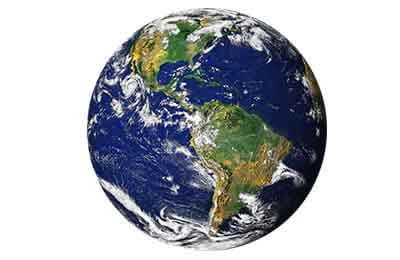干渴的地球
时间:2022-10-30 12:21:00

Each day, the villagers of Marsabit, Kenya, gather at the “singing well.” They sing as they draw water from a well. With little water to spare[剩余], each can fill just one large jug[水壶].
每一天,肯尼亚马萨比特区的村民都会聚集在“唱歌水井”前。他们一边唱歌,一边从井里打水。由于水量很少,每人只能装一个大水壶的水。
The Wonder of Water
Water covers 70 percent of Earth’s surface. So why do the people of Marsabit struggle to get enough of it? We can’t use most of Earth’s water. Nearly 97 percent is salty or otherwise undrinkable. Another two percent is locked up in glaciers[冰川] and ice caps[冰盖]. That leaves only one percent. People, plants, and animals depend on that one percent of fresh water.
Each drop of water is always on the move. It constantly[不断地] moves through an endless cycle above, on, and through the Earth. For example, when the sun beats down[(烈日)照射] on the ocean, water evaporates[蒸发]. It rises into the sky as vapor[水蒸气]. The vapor forms clouds. Later, the vapor condenses[液化,浓缩] and falls as rain or snow. Next thing you know, you’ve got an indoor recess[休息时间]! The rain and snow soak into[吸(渗)入] schoolyards, soccer fields, and lawns. Water seeps[渗出] into creeks[小溪] and rivers. Then it flows back into the ocean.
神奇的水
地球百分之七十的表面被水覆盖着,那么马萨比特的人要获得足够的水怎会如此艰难呢?因为地球上大部分的水都无法使用。接近百分之九十七的水资源是咸水或不能饮用的。另外的百分之二凝结成冰川和冰帽。于是只剩下百分之一。人类和动植物都要依赖这百分之一的淡水生存。
每一滴水总是在不停地运动。水在地球的上空、表面和内部不停移动,形成一个无休止的循环。例如,当太阳照射着大海,水就会蒸发,上升到天空变成水蒸气。水蒸气形成云,然后液化,以雨或雪的形式落下。接着,你的课间休息就要待在室内了!雨和雪渗入操场、足球场和草坪,水渗入小溪和江河,然后流回大海。
Quenching [止(渴)] the Thirst
Water has been recycled like this for millions of years. The amount of water on our planet never changes. The water that drips from your faucet[龙头] today could be the same water that dinosaurs drank long ago.
All living things need water to survive, and that includes plants. In some plants, roots suck up water from the ground. In other plants, leaves and stems[茎] take in water. On a hot summer day, a thirsty birch[桦树] tree can sop up 300 liters of water from the ground. That tree can then release almost the same amount into the air as water vapor.
In dry places, plants must make every drop count. A desert cactus’ leaves store water. Some plants become dormant[睡眠状态的] during extremely dry times. When rain finally falls, they burst back to life in an explosion of color.
Plants use water to spread their seeds, too. The moving water can take plant seeds to faraway places. Some plants make seeds that float, like coconuts. They have a woody, waterproof covering. This lets them bob[上下摆动] along in salty water for long periods. When they reach a new island, they can take root.
为地球止渴
水像这样不断循环已经有数百万年了。地球上水的总量从未改变,今天从你的水龙头滴出来的水可能就是恐龙在很久以前喝过的呢。
所有生物的生存都离不开水,植物也不例外。有些植物用根部从地下吸水,有的则靠叶和茎吸收水分。在炎热的夏天,一棵饥渴的桦树能够从地里吸取300公升水,它随后可以排放出几乎等量的水蒸气。
在干燥的地方,植物更是“滴滴必争”。沙漠仙人掌的叶子能储存水分。在极其干旱的时期,一些植物会进入休眠状态。当雨水终于到来时,它们就会恢复生机,变得五彩缤纷。
植物还利用水散播它们的种子。水流动能够将植物的种子带到远方。有些植物会专门长出可以漂浮的种子,比如椰子。它们有木质的防水外壳,可以在咸水里长时间地跌跌撞撞。到达新的岛屿后,它们就会落地生根。
A Little at a Time
Where there’s water, animals can’t be far behind. Water helps animals take in nutrients[有营养的] and get rid of waste. It helps them keep cool on hot days. If water is hard to find, animals must conserve[保存] water.
A camel can go without drinking water for a long time—sometimes as long as six months. It also saves water by not sweating. How? A camel can change its body temperature during the hottest part of the day. This keeps it from overheating. Because it does not need to sweat to cool itself down, it saves water.
一点一滴
有水的地方就少不了动物。水分有助于动物吸收营养,排出废物;水源在热天帮它们降温。如果难以找到水源,动物们必须储存足够的水。
骆驼可以很长时间不喝水——有时可以长达六个月。骆驼还有一个储水绝招就是不流汗。它们是如何做到的呢?在一天最热的时候,骆驼可以改变自己的体温,避免过热。由于不用流汗降温,它就可以保存水分了。
Watery Homes
Animals don’t just crawl, walk, slither[滑动], or fly to water. Many live in it. Fresh-water habitats[栖息地] are key to their survival.
Some, like most fish, can only live in water. Others, such as frogs, toads[蟾蜍], and many insects, spend part of their life cycle in the water. Still other animals eat the creatures that live in fresh-water habitats.
水的家园
动物不仅用爬的、走的、滑的和飞的等方式接近水源,很多动物干脆生活在水里。淡水栖息地对它们的生存至关重要。
有些动物——像大多数鱼类——只能活在水里。另外一些,如青蛙、蟾蜍和许多昆虫,要在水里度过部分生命周期;还有一些动物则以生活在淡水栖息地的生物为食。
Putting It to Use
You need water, too. You drink it. You use it to bathe, flush[冲洗], wash, and garden. Every American uses about 380 liters of fresh water on average every day. Europeans use about half of that. In the Marsabit village in Kenya where people rely on wells and do not have indoor plumbing[水管装置], each person must get by on as little as 19 liters each day.
People use even more water to make things. Growing food uses the most water of all. It takes 117 liters to grow one pound of potatoes. Livestock[家畜] like cows need even more water. It takes 2,400 liters to “grow” one hamburger! That’s not even counting the wheat to make the bun[小圆面包] or the tomatoes to make the ketchup.
生活用水
你也离不开水。你要喝水、用水洗澡、冲厕所、洗东西和浇花。每一个美国人平均每天要用大约380公升淡水,欧洲人的用量约为美国人的一半。而在肯尼亚马萨比特,由于人们只能靠水井打水,也没有室内水管,每人每天只能靠19公升水度日。
人们在生产中的用水量更大,其中种植业用水最多。种植一磅(0.45公斤)土豆需要117公升水。像母牛之类的牲畜则需要更多水。“种”一个汉堡包要用2400公升水!这还没算上用来制作面包的小麦和制造番茄酱的番茄呢。
Water, Water Everywhere
With so many demands on our fresh water supply, do we have enough? Although Earth is not running out of fresh water, it is not always there for people when and where it’s needed. Some places have too much water. Other places don’t have enough.
Just six countries have half of the world’s supply of fresh water. The people of Greenland have more than enough water. Only 60,000 people live there. Each one has access to millions of liters of water each day.
Yet people in places like the Marsabit village struggle to get the water they need. In some parts of the world, people have to walk many kilometers each day to find water.
水,无处不在
既然那么多东西依赖淡水供应,我们的水足够吗?虽然地球上的淡水不至于用完,但不是说哪里的人有需要就能用上。有些地方的水资源过多,另一些地方则永远不够。
全世界一半的淡水资源分布在六个国家。格陵兰居民的水资源绰绰有余——当地只有六万人居住,每人每天有数百万公升的水。
但是像住在马萨比特的村民则要千辛万苦才能获得所需用水。在世界上一些地方,人们为了找水,每天必须走上数公里路。
Making It Count
To solve some of these problems, people are getting creative. Some merry-go-rounds[旋转木马] in Africa are used to pump[用泵抽(水)] water. Kid power brings clean water from under the ground.
Elsewhere, people carefully conserve water. For some Australians, using it twice is nice. Their shower water doesn’t just go down the drain[排水沟]. Instead, they collect it in buckets. Then they use it to water their plants. Can you think of ways to conserve, too? If everyone saves a little, we can all save a lot!
珍稀每一滴
为了解决这些问题,人们变得越来越有创造力。非洲的一些旋转木马被用作抽水装置,小朋友就可以将干净的水从地下抽上来。
在其他地方,人们将水小心地存起来。有些澳洲人一水两用。他们淋浴过的水不是直接流到排水沟,而是收集到桶里,用来浇灌植物。你能想出什么储水办法吗?如果每个人都节约一点水,加在一起就相当可观了!
